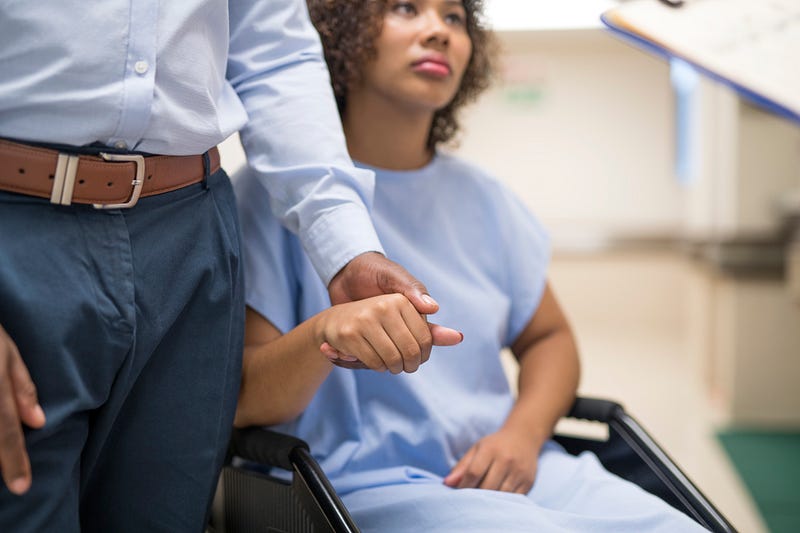Abortion rights are not just a women’s issue. More men should say so.
 Mypartner wasn’t supposed to get pregnant. That’s why she had an IUD — to prevent the pregnancy we both agreed we didn’t want. Liz and I have been together for years, and though we had discussed the idea of having children, we knew we weren’t ready — at least not yet.
Mypartner wasn’t supposed to get pregnant. That’s why she had an IUD — to prevent the pregnancy we both agreed we didn’t want. Liz and I have been together for years, and though we had discussed the idea of having children, we knew we weren’t ready — at least not yet.
And yet there we were last fall, two New Yorkers in a Utah emergency room during an out-of-state trip, holding a brand new sonogram printout. Near the top, a nurse had drawn a white arrow pointing to the six-week-old embryo, and labeled it in big block letters: “BABY.”
We had spent the day rushing to the hospital, worried that a failed IUD might be life-threatening for Liz. We quickly found out that Liz’s life was not in danger, to our immense relief, but we were less confident about her rights. The day of our emergency room visit happened to be on October 7, 2018. And just a day earlier, two thousand miles away, in Washington, D.C., Brett Kavanaugh had been sworn in as a Supreme Court justice.
A darling of the anti-abortion movement, Kavanaugh had written opinions strongly signaling his interest in weakening Roe v. Wade, if not outright reversing it. Many predicted his appointment would open the floodgates for Republican attacks on reproductive rights, and they weren’t wrong. In the months since Kavanaugh took the bench, at least eight states, including Utah, have rolled out draconian restrictions criminalizing abortion as early as six weeks into pregnancy. Some threaten life in prison for women and physicians who fail to comply.
Liz was at least six weeks pregnant, which meant under those new laws an abortion would have made her a felon, facing a jail sentence up to 99 years — as would the doctor who performed the procedure. Under another new law in Georgia, had we been residents and left the state to obtain a legal abortion elsewhere, we’d both be eligible for long prison sentences.
Sitting in her hospital bed in Utah, Liz asked whether I was okay with an abortion. My answer was twofold: First, I agreed with her choice. A baby was the last thing I was ready for. Second, and more importantly, while I appreciated being asked, my opinion didn’t matter. Her body belonged to her, not me, and no pregnancy would change that.
While Liz’s decision was entirely hers, the choice she made to terminate the pregnancy meant I could continue pursuing the personal and professional life I wanted. The laws that protect that choice meant I didn’t lose my partner to a botched back-alley abortion — as so many partners, children, family, and friends did before Roe v Wade — or to a long prison sentence.
Reproductive rights are not only women’s issues — they benefit men, too. We don’t say that often enough.
 The 2018 St. George Marathon was supposed to be Liz’s best ever. She spent months training hard — it was her 20th full marathon — and she hoped to finish in under three hours for the first time. Instead, she spent the race miserable and fighting nausea. We thought her sickness was due to a change in sports drink. Pregnancy never occurred to us. We knew her period was a couple of weeks late, but with her rigorous athletic training, her cycle was sometimes inconsistent — and she had an IUD.
The 2018 St. George Marathon was supposed to be Liz’s best ever. She spent months training hard — it was her 20th full marathon — and she hoped to finish in under three hours for the first time. Instead, she spent the race miserable and fighting nausea. We thought her sickness was due to a change in sports drink. Pregnancy never occurred to us. We knew her period was a couple of weeks late, but with her rigorous athletic training, her cycle was sometimes inconsistent — and she had an IUD.While millions of women have benefitted from safe, legal abortion, so have millions of men like me.
The IUD, short for Intrauterine Device, is a tiny flexible bit of plastic that, once installed, remains in the uterus for years. Some release hormones, but the traditional model — like Liz’s — includes a copper coil that, very simply, makes the womb inhospitable to fertilized eggs. Modern IUDs are safe, affordable (often free, thanks to Obamacare) and very, very reliable. Those rare failures, however, are considered a life-threatening medical emergency.
When Liz woke up nauseous again the morning after the race, I started to worry. Even though pregnancy still seemed like it was a longshot, we figured better safe than sorry. When we stopped by the local Wal-Mart for our traditional celebratory post-race six-pack of beer, we put a pregnancy test on the checkout belt, both confident the tests would come back negative.
Back at the hotel, we opened two beers and she took the first test. I expected to watch anxiously for a few minutes, waiting to see if the little blue line changed into a plus sign. Nope. It changed immediately. So fast, I thought we must have done something wrong. She took the second test, and if anything it came back positive even faster. She was pregnant. Really, really pregnant.
Most importantly, there was that “life-threatening emergency” concern in the back of our minds. IUDs are an exceedingly reliable form of birth control, immune to user error. But failures carry a high risk of ectopic pregnancy when a fertilized egg attaches where it’s not supposed to. Left to develop too long, an ectopic pregnancy becomes a maternal time bomb. We called Liz’s gynecologist, who sent us straight to urgent care — who in turn sent us to the nearest hospital ER. Our celebratory beers sat forgotten and mostly full on our hotel countertop as I anxiously drove the picturesque Utah highways on our way to the hospital.
We talked on the ride about what came next. If the pregnancy was ectopic, then doctors would have to terminate. Since ectopic pregnancy is both life-threatening and non-viable, termination to protect the mother’s health is legal without restriction in every state — at least for now. But what if this was a normal uterine pregnancy? I already knew that, even if we chose to have children, she didn’t want to carry. We agreed abortion was the right choice. We knew the laws in New York protected Liz’s reproductive rights, but what were the laws in Utah?
Gentlemen, there’s a fair-to-good chance that you, too, have benefited from the right to reproductive choice.
The fight for reproductive rights had been front-page news for weeks, as Kavanaugh worked his way through a contentious confirmation fight. Liz and I had sent money to Planned Parenthood, we had called and emailed our senators asking them to oppose Kavanaugh’s nomination, but suddenly the stakes felt much more personal.
For the first time, it wasn’t the concept of abortion that worried us. It was our abortion.
 The hospital in St. George admitted us right away and sent Liz for an immediate ultrasound. They quickly ruled out an ectopic pregnancy. Her IUD had shifted from her uterus down to her cervix, the technician told us. It’s incredibly rare, and she seemed surprised that Liz hadn’t felt it. Based on the date of Liz’s last period, and some measurements on the sonogram screen, the technician estimated that her pregnancy was six or seven weeks along.
The hospital in St. George admitted us right away and sent Liz for an immediate ultrasound. They quickly ruled out an ectopic pregnancy. Her IUD had shifted from her uterus down to her cervix, the technician told us. It’s incredibly rare, and she seemed surprised that Liz hadn’t felt it. Based on the date of Liz’s last period, and some measurements on the sonogram screen, the technician estimated that her pregnancy was six or seven weeks along.
At this point, we learned how laws governing reproductive rights vary by state. The technician played us the embryo’s heartbeat. She told us the due date and printed a picture for Liz to take home. But first, she took the time to add her little arrow and the word “BABY” in big bold letters. I quietly seethed watching this. Liz had told the technician right up front that she intended to terminate. But under Utah law, these steps are mandatory before a woman is allowed an abortion. Patients are forced to hear the heartbeat, learn the due-date, receive pamphlets, and then wait 72 hours before the abortion would be legal.
In the decades since Roe v Wade guaranteed the right to legal abortion, before Kavanaugh’s appointment helped trigger more extreme measures, many states created onerous barriers to make abortions harder to obtain. The 72-hour waiting period, for instance, forces residents of large states with few abortion clinics to either make two trips, or pay for time away from work, travel, and local lodging, driving up costs to make abortion almost impossible for those living in poverty.
But state abortion laws vary dramatically. Our home state of New York, for instance, places few barriers or restrictions on the right to an abortion before the 24-week mark. Under a new law passed in January, the state no longer allows criminal prosecution of anyone who performs an abortion in good faith.
Since the doctors said Liz’s life wasn’t in danger, she elected to wait until we returned to New York City to undergo the procedure. A week later, we visited Planned Parenthood’s Margaret Sanger Health Center in Manhattan, where Liz could undergo a safe, legal abortion — and have a new IUD installed.
Afterward, Liz wanted to fight the stigma around abortion by vocally and publicly sharing her experience. Since then, she often talks about the women who have approached her — friends, family, and even total strangers at races and running classes — to thank her for sharing her story, many confessing that they never felt comfortable telling people about their abortions. Shame and stigma are powerful weapons for the anti-abortion movement.
And me? While I’ve never denied or covered up the experience, I’ve never before written about it. I thought of it as Liz’s story to tell — but with her consent, it’s my story too.
Reproductive rights and abortion, in particular, affect all of us. Abortion is often referred to as “a woman’s right to choose,” but the conversation shouldn’t be limited to binary terms. While millions of women have benefitted from safe, legal abortion, so have millions of men like me, though many of us might not know it.
Statistics say one in four women under age 45 have had an abortion. The stories Liz has heard prove that many women keep their abortions secret — including, pretty often, from the men who played their part.
So, gentlemen, there’s a fair-to-good chance that you, too, have benefited from the right to reproductive choice. Maybe you know it, maybe you don’t. And even if you already have children, don’t think I’m not talking to you: More than half of women who have abortions are already mothers.
Thanks to that Utah sonogram technician, we know our baby would have been due any day now, had Liz chose (or been forced) to carry the pregnancy to term. She and I could be revising our lives to accommodate the child we never wanted. Thanks to the availability of safe, legal abortion, we are both free to pursue the lives we choose.
When Liz asked me about her abortion, I told her it was no one’s decision but hers. Unless American men raise their voices in defense of reproductive freedom and bodily autonomy, that may not be true for much longer.


No comments:
Post a Comment